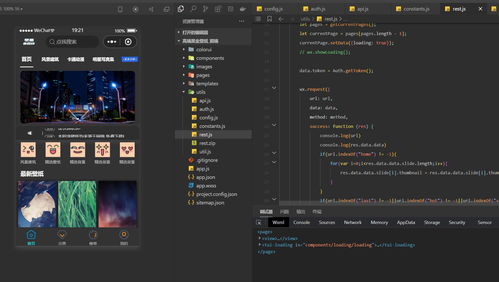图像修复的代码(图像修复的代码是什么)
admin 发布:2022-12-19 12:33 111
本篇文章给大家谈谈图像修复的代码,以及图像修复的代码是什么对应的知识点,希望对各位有所帮助,不要忘了收藏本站喔。
本文目录一览:
- 1、matlab图像复原维纳滤波,最小二乘方,L-R,盲去卷积图像复原比较的程序代码
- 2、照片损坏如何恢复
- 3、照片损坏如何修复?
- 4、如何用matlab编程将运动模糊图像用维纳滤波法复原?
- 5、excel点击图片放大恢复正常代码
- 6、求基于BP神经网络的图像复原算法的matlab代码
matlab图像复原维纳滤波,最小二乘方,L-R,盲去卷积图像复原比较的程序代码
clc;clear all;
%读原始图像%
format long
Blurred=imread('fig525(b).bmp');
subplot(1,2,1);imshow( Blurred);title('原图像');
%自编函数进行维纳滤波%
k=0.0025;
[m,n]=size(Blurred);
spectrum=zeros(m,n);
H=zeros(m,n);
for u=1:m
for v=1:n
H(u,v)=exp(-k*((u-m/2)^2+(v-n/2)^2)^(5/6));
spectrum(u,v)=H(u,v)^2;
end
end
f=double(Blurred);
F1=fftshift(fft2(f));
HW=H./(spectrum+0.001);
restore1=HW.*F1;
restored=real(ifft2(ifftshift(restore1)));
subplot(1,2,2);imshow(restored,[]);title('自编函数进行维纳滤波');
%调用matlab提供的维纳滤波函数%
figure;
hw1=real(ifft2(ifftshift(H)));%转化到空域上来
result1=deconvwnr(Blurred,hw1,0.001);
result2=ifftshift(result1);%再去图像进行1,3象限对调,2与4象限对调
subplot(1,2,1);imshow(result2,[]);title('调用维纳滤波函数');
照片损坏如何恢复
第一种方法:
在损坏的图像点击鼠标右键的打开方式,用UltraEdit打开。
然后看看图片二进制代码有没有损坏,
然后拷贝一个可以正常观看的图片格式,用UltraEdit打开参考它的文件开头和文件结束数据块,
然后在你损坏的JPG文件添加正确的文件开头和结束数据块,
第二种方法:
用最新版PHTOPOSHOP9。0(图像编辑软件)打开试试看看,
然后在另存你想要的格式图片这样就可以正常观看了
照片恢复不成功因素: 删除、剪切或格式化后又放入新文件,将原来内容覆盖破坏
照片损坏如何修复?
您好,方法步骤如下:
1、首先打开格式工厂,用格式工厂,进行照片的修复,到网页浏览器界面,可以下载格式工厂点击右下角的普通下载。
2、下载好之后要对软件进行安装,可以安装到d盘,避免磁盘不必要的浪费空间以及卡顿,安装完后我们要对格式工厂进行调整,可以调动一些小的参数,如果是新人就不必调动格式工厂的数据。
3、打开软件格式工厂后,要注意看界面,有一个图片选项,点进去打开之后要对图片的格式进行调整。如果之前损坏的是gif格式我们要对格式进行改动把它调整成JPG或NPG的格式因为只有这两种格式。
4、点击右方的添加文件,进行打开 按确定,然后添加文件到格式工厂选择添加文件。
5、最后选择已经损坏的照片,按确定即可。

如何用matlab编程将运动模糊图像用维纳滤波法复原?
PSF
=
fspecial('motion',len,ang);
%建立扩散子,其中len是模糊长度,ang是模糊角度
img2=deconvlucy(img,PSF,n);
%用lucy-richardson方法复原图像,其中img是运动模糊图像,PSF是扩散子,n是迭代次数,img2是复原图像
excel点击图片放大恢复正常代码
Dim
v
As
Boolean,
s_with,
s_height
Sub
zoomandback()
ActiveSheet.Shapes("矩形
1").Select
If
v
=
False
Then
Selection.ShapeRange.ScaleWidth
2.5,
msoFalse,
msoScaleFromTopLeft
Selection.ShapeRange.ScaleHeight
2.5,
msoFalse,
msoScaleFromTopLeft
v
=
True
Else
Selection.ShapeRange.ScaleWidth
0.4,
msoFalse,
msoScaleFromTopLeft
Selection.ShapeRange.ScaleHeight
0.4,
msoFalse,
msoScaleFromTopLeft
v
=
False
End
If
End
Sub
其中“矩形1”换成你的图片的代码,然后将这段宏zoomandback指定给你的图片就OK了
求基于BP神经网络的图像复原算法的matlab代码
function Solar_SAE
tic;
n = 300;
m=20;
train_x = [];
test_x = [];
for i = 1:n
%filename = strcat(['D:\Program Files\MATLAB\R2012a\work\DeepLearn\Solar_SAE\64_64_3train\' num2str(i,'%03d') '.bmp']);
%filename = strcat(['E:\matlab\work\c0\TrainImage' num2str(i,'%03d') '.bmp']);
filename = strcat(['E:\image restoration\3-(' num2str(i) ')-4.jpg']);
b = imread(filename);
%c = rgb2gray(b);
c=b;
[ImageRow ImageCol] = size(c);
c = reshape(c,[1,ImageRow*ImageCol]);
train_x = [train_x;c];
end
for i = 1:m
%filename = strcat(['D:\Program Files\MATLAB\R2012a\work\DeepLearn\Solar_SAE\64_64_3test\' num2str(i,'%03d') '.bmp']);
%filename = strcat(['E:\matlab\work\c0\TestImage' num2str(i+100,'%03d') '-1.bmp']);
filename = strcat(['E:\image restoration\3-(' num2str(i+100) ').jpg']);
b = imread(filename);
%c = rgb2gray(b);
c=b;
[ImageRow ImageCol] = size(c);
c = reshape(c,[1,ImageRow*ImageCol]);
test_x = [test_x;c];
end
train_x = double(train_x)/255;
test_x = double(test_x)/255;
%train_y = double(train_y);
%test_y = double(test_y);
% Setup and train a stacked denoising autoencoder (SDAE)
rng(0);
%sae = saesetup([4096 500 200 50]);
%sae.ae{1}.activation_function = 'sigm';
%sae.ae{1}.learningRate = 0.5;
%sae.ae{1}.inputZeroMaskedFraction = 0.0;
%sae.ae{2}.activation_function = 'sigm';
%sae.ae{2}.learningRate = 0.5
%%sae.ae{2}.inputZeroMaskedFraction = 0.0;
%sae.ae{3}.activation_function = 'sigm';
%sae.ae{3}.learningRate = 0.5;
%sae.ae{3}.inputZeroMaskedFraction = 0.0;
%sae.ae{4}.activation_function = 'sigm';
%sae.ae{4}.learningRate = 0.5;
%sae.ae{4}.inputZeroMaskedFraction = 0.0;
%opts.numepochs = 10;
%opts.batchsize = 50;
%sae = saetrain(sae, train_x, opts);
%visualize(sae.ae{1}.W{1}(:,2:end)');
% Use the SDAE to initialize a FFNN
nn = nnsetup([4096 1500 500 200 50 200 500 1500 4096]);
nn.activation_function = 'sigm';
nn.learningRate = 0.03;
nn.output = 'linear'; % output unit 'sigm' (=logistic), 'softmax' and 'linear'
%add pretrained weights
%nn.W{1} = sae.ae{1}.W{1};
%nn.W{2} = sae.ae{2}.W{1};
%nn.W{3} = sae.ae{3}.W{1};
%nn.W{4} = sae.ae{3}.W{2};
%nn.W{5} = sae.ae{2}.W{2};
%nn.W{6} = sae.ae{1}.W{2};
%nn.W{7} = sae.ae{2}.W{2};
%nn.W{8} = sae.ae{1}.W{2};
% Train the FFNN
opts.numepochs = 30;
opts.batchsize = 150;
tx = test_x(14,:);
nn1 = nnff(nn,tx,tx);
ty1 = reshape(nn1.a{9},64,64);
nn = nntrain(nn, train_x, train_x, opts);
toc;
tic;
nn2 = nnff(nn,tx,tx);
toc;
tic;
ty2 = reshape(nn2.a{9},64,64);
tx = reshape(tx,64,64);
tz = tx - ty2;
tz = im2bw(tz,0.1);
%imshow(tx);
%figure,imshow(ty2);
%figure,imshow(tz);
ty = cat(2,tx,ty2,tz);
montage(ty);
filename3 = strcat(['E:\image restoration\3.jpg']);
e=imread(filename3);
f= rgb2gray(e);
f=imresize(f,[64,64]);
%imshow(ty2);
f=double (f)/255;
[PSNR, MSE] = psnr(ty2,f)
imwrite(ty2,'E:\image restoration\bptest.jpg','jpg');
toc;
%visualize(ty);
%[er, bad] = nntest(nn, tx, tx);
%assert(er 0.1, 'Too big error');
关于图像修复的代码和图像修复的代码是什么的介绍到此就结束了,不知道你从中找到你需要的信息了吗 ?如果你还想了解更多这方面的信息,记得收藏关注本站。
版权说明:如非注明,本站文章均为 AH站长 原创,转载请注明出处和附带本文链接;
相关推荐
- 05-17seo全称是什么意思,seo全拼
- 05-17做公司网页,做公司网页有什么简单的方法
- 05-17seo信息是什么,seo内容是什么意思
- 05-16设计师经常用的网站,设计师一般用什么网站
- 05-16seo网络推广技术,seo网络推广什么意思
- 05-16外包公司什么意思,外包公司什么意思缺点
- 05-15零基础学什么技术好,零基础学什么技术好开店
- 05-15网络维护是做什么的,网络维护是做什么的好学吗
- 05-14外链网站是什么,外链是啥
- 05-14网络推广员的工作内容和步骤,网络推广员的工作内容和步骤是什么
取消回复欢迎 你 发表评论:
- 标签列表
- 最近发表
- 友情链接


